If you’re looking for an incredible gaming experience, then a water cooled gaming PC is definitely the way forward. These rigs offer unbeatable power and speed, with water cooling systems that ensure your computer stays cool even during the most intense gaming sessions. But before you jump into purchasing a water cooled gaming PC, there are some important factors that you need to consider.
First and foremost, consider the needs of your games. If you’re looking to run particularly demanding games, then you’ll need to invest in a water cooled gaming PC with a robust cooling system. Additionally, take into account the size of the computer and ensure that it fits within your space, as well as your budget. Finally, consider the reputation and reliability of the company. Buying from well-established, reputable providers is always a smart idea, ensuring that you get the best experience possible.
Do you want to see your favourite games in stunning detail and with lightning fast speed? Are you fed up with your computer overheating during crucial moments in the game? Do you want to invest in a high-quality desktop that will offer years of fast, reliable gaming? If so, it’s time to start considering a water cooled gaming PC. With unbeatable speed, power, and cooling, these gaming rigs are a must for the serious gamer who wants the best possible experience. So why wait? Start your search today and find the perfect water cooled gaming PC for your needs.
10 Best Water Cooled Gaming Pc
| # | Product Image | Product Name | Product Notes | Check Price |
|---|---|---|---|---|
|
1
|
Ideal for high-performance virtual reality gaming with a water-cooled processor, powerful graphics card, ample memory, and speedy storage.
|
|
||
|
2
|
Ideal for high-performance gaming and virtual reality experiences with advanced processing power, graphics, and fast storage.
|
|
||
|
3
|
This product is ideal for high-performance virtual reality gaming and other intensive computer applications.
|
|
||
|
4
|
Ideal for high-end gaming and demanding tasks with liquid-cooled Intel processor, RTX graphics card, 16GB RAM, and high-speed storage.
|
|
||
|
5
|
This product is ideal for high-performance gaming and VR experiences with its powerful processor, graphics card, and ample storage.
|
|
||
|
6
|
This product is ideal for high-performance gaming with a liquid-cooled CPU, fast RAM, powerful GPU, and ample storage.
|
|
||
|
7
|
This product is ideal for gaming enthusiasts seeking high-performance, liquid-cooled PC with an AMD processor and RTX graphics.
|
|
||
|
8
|
This product is ideal for high-performance gaming and intensive computing tasks with its liquid-cooled CPU, powerful RTX graphics, and fast NVMe storage.
|
|
||
|
9
|
The product is ideal for high-performance gaming and demanding computing tasks with its powerful processor, graphics card, and fast storage.
|
|
||
|
10
|
This product is ideal for building a high-performance gaming PC with water-cooling capabilities, featuring pre-installed RGB fans and tempered glass panels.
|
|
1. Alpha Vr Gaming Pc – Ultimate Watercooled Fun!
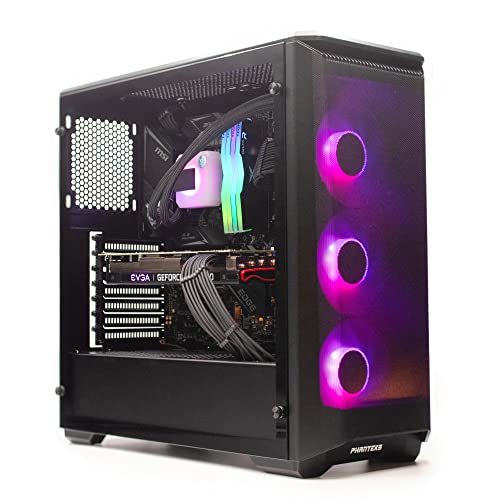
The Apex Alpha is a high-performance gaming desktop that is designed to deliver exceptional gaming experiences. It features a powerful i5-11600KF 3.9GHz processor that is water-cooled with a 240MM CPU cooler to ensure maximum cooling efficiency. The desktop also comes with an RTX 3060 GPU that offers incredible graphics performance, allowing you to enjoy your favorite games with stunning visuals. The 16GB DDR4-3600 RGB RAM provides ample memory for multitasking, while the 500GB SATA SSD offers fast storage for your games and other files.
The Apex Alpha is built using only high-quality components from large reputable brands. This ensures that the system is not only powerful but also reliable and long-lasting. The desktop comes with a B560M motherboard which provides compatibility with the latest hardware and connectivity options.
Connectivity is not an issue with the Apex Alpha as it comes with 9 USB ports, 1 Ethernet port, 1 WiFi dongle, and 1 Bluetooth dongle. This allows you to connect all your peripherals and devices without any hassle. The system runs on Windows 11 Pro, which is the latest and most advanced operating system from Microsoft.
In summary, the Apex Alpha is a top-of-the-line gaming desktop that offers exceptional performance and reliability. It is built with high-quality components and comes with a water-cooled CPU cooler to ensure maximum cooling efficiency. With its powerful processor, fast storage, and advanced graphics card, the Apex Alpha is perfect for gamers who demand the best.
- Powerful i5-11600KF 3.9GHz processor with water-cooled 240MM CPU cooler
- RTX 3060 GPU for incredible graphics performance
- 16GB DDR4-3600 RGB RAM for multitasking
- 500GB SATA SSD for fast storage
- High-quality components from reputable brands
- B560M motherboard with latest hardware and connectivity options
- 9 USB ports, 1 Ethernet port, 1 WiFi dongle, and 1 Bluetooth dongle for easy connectivity
- Runs on the latest Windows 11 Pro operating system
- – May be expensive for some users
2. Xtreme Watercooled Vr Gaming Beast
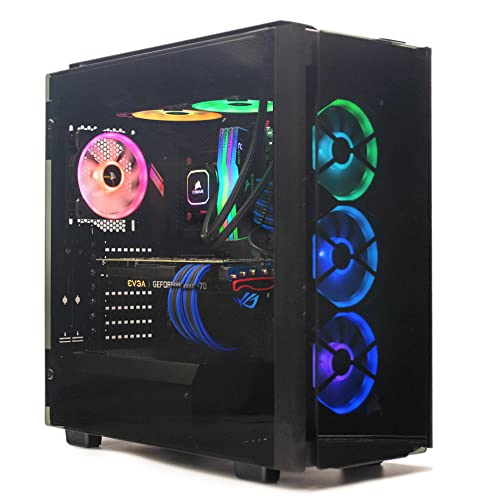
The Apex Xtreme gaming desktop boasts a powerful i9-12900KF 3.9GHz processor, making it the perfect choice for intensive gaming and demanding tasks. This desktop is equipped with a water-cooled CPU cooler that guarantees efficient cooling, allowing for maximum performance without the risk of overheating. It also comes with an RTX 3080 graphics card, which provides stunning visuals and smooth gameplay. The desktop features 32GB DDR4-3600 RGB RAM and a 500GB NVMe SSD, ensuring that all your gaming needs are met with lightning-fast speed and responsiveness.
The Apex Xtreme desktop is built with high-quality parts from large, reputable brands, ensuring that the system is reliable and durable. The Z590 motherboard provides excellent connectivity options, including 13 USB ports, 2 Ethernet ports, 1 WiFi dongle, and 1 Bluetooth dongle, giving you the freedom to connect all your devices with ease. The system is pre-installed with Windows 11 Pro, providing a secure and stable operating system for all your gaming and productivity needs.
The water cooling system allows for quieter operation and better performance than traditional air coolers. It is a 360MM cooler that provides efficient cooling, even during extended gaming sessions. The Apex Xtreme gaming desktop is a high-quality system that is built to deliver exceptional performance and reliability.
In summary, the Apex Xtreme gaming desktop is a powerful and reliable system that is designed to meet the needs of even the most demanding gamers. With its high-quality components, efficient water-cooled CPU cooler, and excellent connectivity options, this desktop is the perfect choice for anyone looking for a top-of-the-line gaming experience.
- Powerful i9-12900KF 3.9GHz processor for maximum performance
- Water-cooled CPU cooler for efficient cooling and quieter operation
- High-quality components from reputable brands for reliable and durable performance
- Excellent connectivity options with 13 USB ports, 2 Ethernet ports, 1 WiFi dongle, and 1 Bluetooth dongle
- Stunning visuals and smooth gameplay with the RTX 3080 graphics card
- – Expensive compared to other gaming desktops on the market
- – Limited storage capacity with only a 500GB NVMe SSD
3. Platinum Vr Gaming Pc: Apex Powerhouse

The powerful and reliable gaming desktop is equipped with high-quality components, including an AMD Ryzen 5 5500 processor, water-cooled CPU cooler, and RTX 3070 graphics card, providing excellent gaming performance and smooth multitasking. It also features 16GB DDR4-3600 RGB RAM, an A520 motherboard, and a fast 256GB NVMe SSD to store your games and files.
In addition to its impressive hardware, this gaming desktop comes with Windows 11 Pro, providing a modern and streamlined user experience. It also features 13 USB ports, 2 Ethernet ports, 1 WiFi dongle, and 1 Bluetooth dongle, ensuring that you can connect all of your peripherals and devices with ease.
This gaming desktop is built with parts from only large high-quality brands, ensuring that you are getting a reliable and long-lasting product. Whether you're a professional gamer or just looking for a powerful and reliable desktop computer, this gaming desktop is a great choice.
- Powerful and reliable gaming performance
- High-quality components from trusted brands
- Windows 11 Pro for a modern user experience
- Plenty of connectivity options for all your peripherals
4. Arcticliquid Gaming Desktop By Thermaltake.
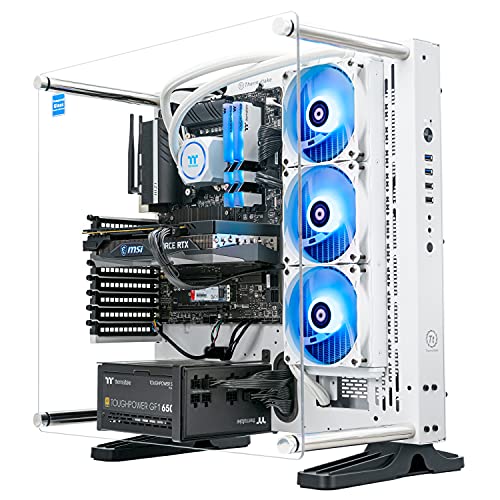
The Intel Core i5-11600K CPU Watercooled PC is a high-performance desktop computer that offers top-of-the-line features for a smooth and seamless experience. The CPU is watercooled to ensure optimal performance even during intense usage. The PC is powered by an Intel Z590 Chipset ATX motherboard that provides reliable and efficient performance. It comes with 16GB ToughRam DDR4 RGB that ensures a seamless multitasking experience. The PC also comes with a 1TB NVMe M.2 for storage, WiFi for connectivity, and Windows 10 Home as the operating system.
The NVIDIA GeForce RTX 3060 is the graphics card of choice, ensuring that users can enjoy high-quality graphics and visuals. While the graphics card brand may vary, users can expect only the best performance. The Closed Loop Liquid Cooling with 360mm Radiator ensures that the PC remains cool even during intense usage, enabling users to work for hours without any hiccups. The Panoramic Open Frame Design with 5mm Thick Tempered Glass Panel offers a sleek and modern look that enhances the overall aesthetic appeal of the PC.
The PC also features 2x USB 3.0, 2x USB 2.0, 1x Headphone, and 1x Mic Ports for easy connectivity. Overall, the Intel Core i5-11600K CPU Watercooled PC is an excellent choice for those looking for a high-performance desktop computer that offers top-of-the-line features and reliable performance.
- Watercooled CPU ensures optimal performance even during intense usage
- 16GB ToughRam DDR4 RGB ensures a seamless multitasking experience
- 1TB NVMe M.2 provides ample storage space
- NVIDIA GeForce RTX 3060 graphics card offers high-quality graphics and visuals
- Closed Loop Liquid Cooling with 360mm Radiator keeps the PC cool even during intense usage
- Panoramic Open Frame Design with 5mm Thick Tempered Glass Panel offers a sleek and modern look
- – The graphics card brand may vary
5. Ultimate Gaming Powerhouse: Alienware Aurora R10
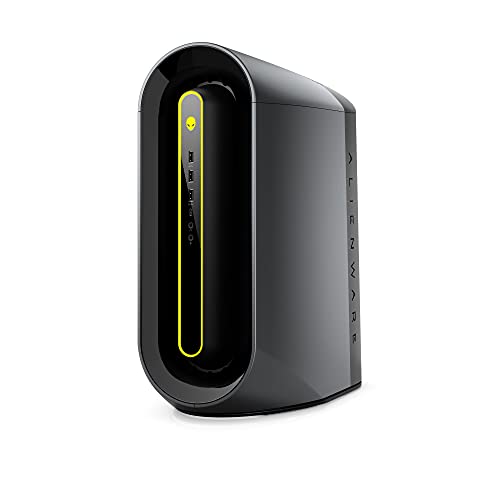
The Alienware Aurora R10 Ryzen Edition Gaming Desktop PC is a powerful gaming computer designed to provide top-notch performance to gamers. Equipped with a 12-core AMD Ryzen processor, this gaming desktop computer is capable of delivering a powerful performance that can handle even the most demanding games and applications with ease.
The gaming desktop comes with 32GB 3466Mhz XMP overclockable DDR4 memory that ensures a seamless gaming experience. It allows gamers to power through their favorite games or edit their favorite maps without any lag.
The Alienware Aurora R10 Ryzen Edition Gaming Desktop PC is equipped with the latest technology, including PCI-Express 4.0 that provides graphics, storage drives, and networking adapters with greater bandwidth. This ensures that every component in the gaming desktop performs at the highest level.
The gaming desktop comes with an upgraded chassis based on the Legend Industrial Design that allows for liquid cooling and efficient airflow to reduce CPU temperatures. This results in whisper-quiet operation, making it an ideal choice for gamers who prefer quiet gaming sessions.
The Alienware Aurora R10 Ryzen Edition Gaming Desktop PC has thoughtfully positioned front I/O ports and easy-to-reach rear ports that offer flexibility. Additionally, it comes with upgradeable components that make it easy to upgrade the gaming desktop as per the user's requirements. The AlienFX lighting further enhances the accessibility and visibility of the gaming desktop.
- Powerful 12-core AMD Ryzen processor for a top-notch performance
- 32GB 3466Mhz XMP overclockable DDR4 memory for seamless gaming experience
- Equipped with the latest technology including PCI-Express 4.0 that provides graphics, storage drives, and networking adapters with greater bandwidth
- Upgraded chassis based on the Legend Industrial Design that allows for liquid cooling and efficient airflow to reduce CPU temperatures
- Thoughtfully positioned front I/O ports, easy-to-reach rear ports, and upgradeable components offer flexibility
- AlienFX lighting enhances accessibility and visibility of the gaming desktop
6. Toughram Gaming Pc With Rtx 3060
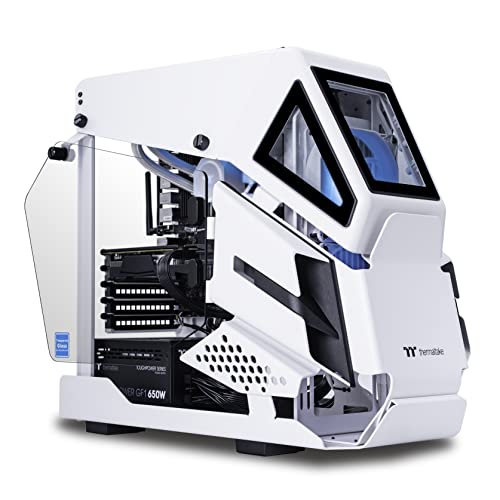
The AMD Ryzen 5 5600X CPU Watercooled with Closed Loop Liquid Cooling and 240mm Radiator is a high-performance processor that delivers smooth and seamless gaming, streaming, and multitasking experience. The CPU is paired with an AMD B550 Chipset mATX motherboard that provides high-speed connectivity and efficient data transfer. The system also includes 16GB ToughRam DDR4 RGB that enhances the overall performance of the system, and a 1TB NVMe M.2 that provides ample storage space for games, media, and applications.
The NVIDIA GeForce RTX 3060 Graphics Card is a high-end graphics card that provides immersive and realistic gaming experience. The graphics card comes with 3x Display Port/1x HDMI, which allows users to connect multiple displays to the system. Please note that the graphics card brand may vary.
The system also includes WiFi and Windows 10 Home, which provides seamless connectivity and a user-friendly interface. The open frame case AH T200 Snow is designed for best airflow and ensures that the system stays cool and quiet during intensive tasks. The case also features 1x Type C USB, 2x USB 3.0, 1x Headphone, and 1x Mic Ports, which provides easy access to peripherals.
Overall, this system is a great choice for gamers, content creators, and professionals who are looking for a high-performance and reliable system that can handle intensive tasks with ease.
- High-performance AMD Ryzen 5 5600X CPU Watercooled with Closed Loop Liquid Cooling and 240mm Radiator
- 16GB ToughRam DDR4 RGB enhances the overall performance of the system
- 1TB NVMe M.2 provides ample storage space for games, media, and applications
- NVIDIA GeForce RTX 3060 Graphics Card provides immersive and realistic gaming experience
- Open frame case AH T200 Snow is designed for best airflow and ensures that the system stays cool and quiet during intensive tasks
- WiFi and Windows 10 Home provide seamless connectivity and a user-friendly interface
- – Graphics card brand may vary
7. Ultimate Liquid Gaming Pc With Rtx 3060
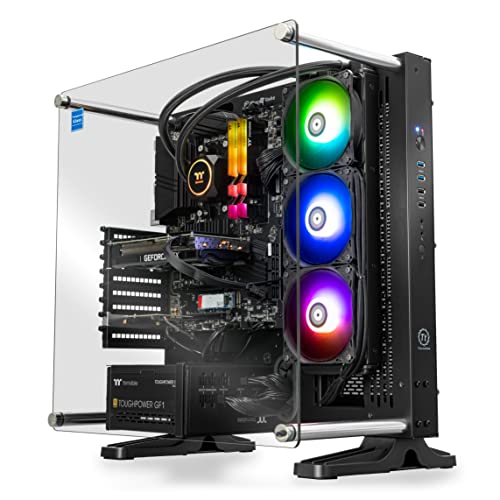
The AMD Ryzen 5 5600X CPU Watercooled System is a high-performance PC designed for gamers and professionals who demand speed and power. This system features an AMD B550 Chipset ATX motherboard, which provides excellent connectivity and stability. The motherboard supports the latest PCIe 4.0 standard, allowing for faster data transfer rates and improved performance. The system also comes with 16GB ToughRam DDR4 RGB, offering fast and reliable memory for intense multitasking and gaming. In addition, the 1TB NVMe M.2 provides ample storage space for all your files and games.
The NVIDIA GeForce RTX 3060 12GB Graphic card offers stunning graphics and smooth gameplay. The graphics card brand may vary, but you can rest assured that it will be a high-quality product. The Closed Loop Liquid Cooling with 360mm Radiator keeps your system cool and quiet, allowing you to focus on your gaming or work. The system also features 2x USB 3.0, 2x USB 2.0, 1x Headphone, and 1x Mic Ports for easy connectivity. The Panoramic Open Frame Design with 5mm Thick Tempered Glass Panel gives the system a stylish and modern look, allowing you to show off your components in style.
This system comes pre-installed with Windows 10 Home, providing you with a familiar and user-friendly operating system. The WiFi connectivity ensures that you can connect to the internet wirelessly, giving you more flexibility with your setup. Overall, the AMD Ryzen 5 5600X CPU Watercooled System is a powerful and reliable PC that is perfect for gamers and professionals who want the best performance and quality.
- Powerful AMD Ryzen 5 5600X CPU Watercooled
- High-performance NVIDIA GeForce RTX 3060 12GB Graphic card
- 16GB ToughRam DDR4 RGB for fast and reliable memory
- 1TB NVMe M.2 provides ample storage space
- Closed Loop Liquid Cooling with 360mm Radiator keeps system cool and quiet
- Panoramic Open Frame Design with 5mm Thick Tempered Glass Panel for a modern look
- Comes pre-installed with Windows 10 Home for ease of use
- WiFi connectivity for wireless internet access
- – Price may be too high for some budget-conscious buyers
- – Graphics card brand may vary
8. Shadow360i Pro Gaming Pc By Thermaltake
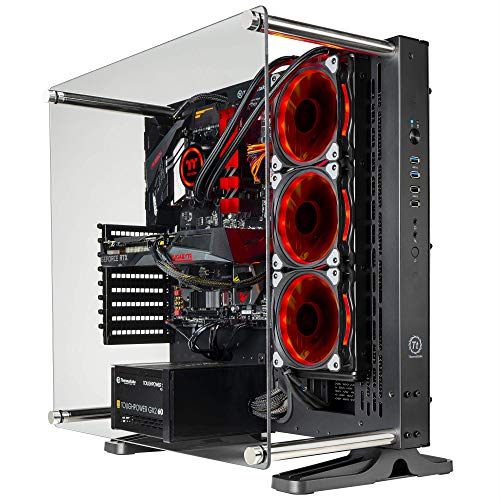
The AMD Ryzen 5 3600 CPU Watercooled Desktop PC is a powerful and efficient system that provides superior performance for both gaming and work-related tasks. It comes equipped with an AMD B450 Chipset ATX motherboard, 16GB ToughRam DDR4 RGB, 1TB NVMe M.2, WiFi, and Windows 10 Home. The NVIDIA GeForce RTX 3060 Ti 8GB graphics card with 2x Display Port/2x HDMI provides a stunning visual experience, with brand may vary. The closed loop liquid cooling system with 360mm radiator ensures that the CPU stays cool even during intensive tasks. The system has 2x USB 3.0, 2x USB 2.0, 1x Headphone, and 1x Mic Ports for easy connectivity. The panoramic open frame design with 5mm thick tempered glass panel provides a sleek and modern appearance, making it an eye-catching addition to any workspace or gaming setup.
The AMD Ryzen 5 3600 CPU Watercooled Desktop PC is designed to meet the demands of gamers and professionals alike. The system's powerful components and efficient design ensure that tasks are completed quickly and efficiently. With its stunning graphics and liquid cooling system, this desktop PC provides an exceptional gaming experience. Moreover, its open frame design and tempered glass panel make it a great addition to any workspace.
The AMD Ryzen 5 3600 CPU Watercooled Desktop PC is an excellent choice for those who require a high-performance computer system. Its powerful components, efficient liquid cooling system, and sleek design make it ideal for gamers and professionals alike.
- Powerful and efficient AMD Ryzen 5 3600 CPU Watercooled system
- NVIDIA GeForce RTX 3060 Ti 8GB graphics card provides stunning visuals
- Closed loop liquid cooling system with 360mm radiator ensures CPU stays cool
- Panoramic open frame design with 5mm thick tempered glass panel provides a sleek and modern appearance
- – Graphics card brand may vary
9. Ultimate Gaming Powerhouse" – Thermaltake Reactor 380
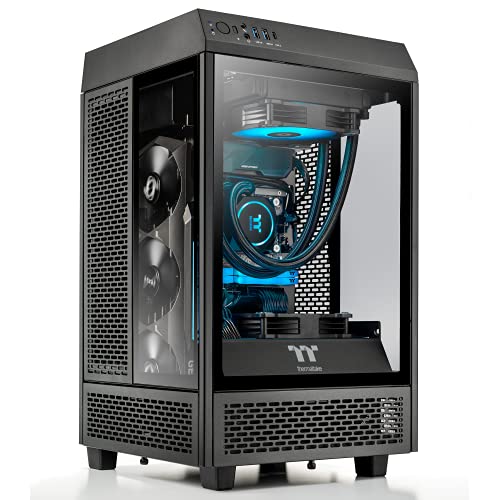
Experience ultimate gaming performance with the Compact Performance B550 mITX motherboard equipped with an AMD Ryzen7 5800X processor. This motherboard offers a range of features including a Display Port and HDMI with the NVIDIA GeForce RTX 3080 graphics card, which delivers stunning visuals and an immersive gaming experience. The graphics card brand may vary, but the performance will remain top-notch.
The ToughRAM RGB – 16GB 3600Mhz DDR4 RGB Memory paired with the Seagate FireCuda 520 NVMe SSD 1TB storage ensures lightning-fast data transfer and seamless multitasking. This allows you to keep up with the latest games and streaming applications without any lag.
Connectivity-wise, the Compact Performance motherboard comes with 2 x USB 3.0, 1 x USB Type-C, headphone and mic ports, as well as HDMI and DP ports. This lets you connect various peripherals and devices to your system with ease.
The 750W 80PLUS GOLD Power Supply ensures that your system runs smoothly and efficiently, delivering a reliable power source that keeps your system up and running at all times. Overall, the Compact Performance B550 mITX motherboard is an excellent choice for gamers and professionals who demand the best performance and features from their system.
- Powerful AMD Ryzen7 5800X processor
- NVIDIA GeForce RTX 3080 graphics card for stunning visuals
- Lightning-fast data transfer and seamless multitasking with 16GB DDR4 RAM and 1TB NVMe SSD
- Multiple connectivity options including USB 3.0, USB Type-C, HDMI, and DP
- Reliable 750W 80PLUS GOLD Power Supply
10. Gim Rgb Gaming Case With Dual Glass Panels
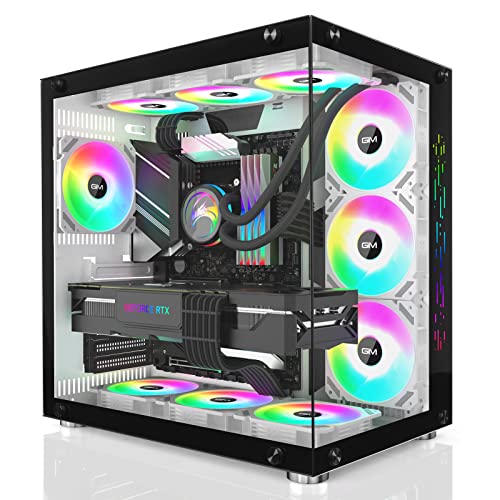
The GIM Gaming Case is designed to provide an exceptional gaming experience with its powerful cooling system that includes 10 pre-installed 120mm GIM ARGB fans. These fans not only create stunning lighting effects but also provide excellent air performance, keeping the system cool for longer gaming sessions. The case supports ATX, Micro-ATX, and Mini-ITX motherboards, providing gamers with a wide range of options for customization.
The case features two 4mm-thick tempered glass full-view side panels that allow gamers to showcase their hardware. The internal space is wide and easy to install with support for 3 x 2.5" SSD, 2 x 3.5" HDD, ATX/Micro ATX/ITX motherboard, and a maximum length 400mm GPU. The cooling system is flexible and supports 3 designated areas for the installation of water coolers with radiators of 360, 240, and 120 mm.
The ARGB lighting system is controlled by the included remote and consists of 10 GIM KB-11 RGB case fans (120mm white Addressable speed adjustable fans), 1 RGB Backplate, and 1 GIM hub. The lighting system creates an amazing lighting show while providing excellent cooling.
The case also features a big space behind the motherboard tray for hidden cable management, improving the interior's aesthetics and cooling performance. It comes with 1 dust filter and a top magnetic strip dust filter that protects the case from dust and debris. The top I/O panel is equipped with USB 3.0 Port, 2 x USB 2.0 Port, 1 x HD Audio, LED Button, Power, Reset, and a shielded USB cable that allows for data transmission without interference.
GIM is committed to providing the best customer service and offers a no-risk purchase policy. If there are any quality issues with the case, customers can contact GIM for assistance.
- Powerful cooling system with 10 pre-installed 120mm GIM ARGB fans
- Supports ATX, Micro-ATX, and Mini-ITX motherboards
- Flexible cooling system supports the installation of water coolers with radiators of 360, 240, and 120 mm
- ARGB lighting system with 10 GIM KB-11 RGB case fans, 1 RGB Backplate, and 1 GIM hub
- Cable management system and dust filters improve the interior's aesthetics and cooling performance
- Top I/O panel equipped with USB 3.0 Port, 2 x USB 2.0 Port, 1 x HD Audio, LED Button, Power, Reset
- – The actual fans received may vary depending on the shipment batch
Best Water Cooled Gaming Pc FAQs
How do you build a water-cooled gaming PC and what components are needed?
Building a water-cooled gaming PC requires a certain level of technical expertise and attention to detail. Firstly, you will need a compatible water cooling system which includes a water block, pump, radiator, reservoir, tubing and coolant. You will also need a compatible CPU and GPU water block as well as a power supply unit.
Once you have all your components, you will need to mount the water block to your CPU and GPU, connect the tubing to the pump and radiator, fill the reservoir with coolant and bleed the system of any air bubbles. It is important to ensure that all components are securely mounted and that there are no leaks in the system.
When selecting components, it is important to consider the compatibility of the water cooling system with the hardware. It is also important to choose components that can handle the additional heat generated by the water cooling system.
Overall, building a water-cooled gaming PC requires careful planning, attention to detail and technical expertise. However, the benefits of a water-cooled system include improved performance and quieter operation.
How much maintenance is required for a water-cooled gaming PC, and what are some common issues to look out for?
Maintaining a water-cooled gaming PC is crucial to ensure optimal performance and longevity of the system. The frequency of maintenance largely depends on the type of cooling system and usage. A custom loop with hard tubing may require more maintenance than an all-in-one liquid cooler. Generally, it is recommended to clean the system every 6-12 months, which involves flushing out the coolant, cleaning the radiators and fans, and checking for leaks. It is also important to monitor the coolant level and temperature regularly.
Common issues to look out for include leaks, which can damage other components and lead to system failure. Another issue is the buildup of algae and debris in the coolant, which can clog the system and cause overheating. It is important to use high-quality coolant and components to prevent these issues. Additionally, it is advisable to have a backup plan in case of system failure, such as a spare computer or an alternative cooling solution. Overall, proper maintenance and caution can help prevent common issues and ensure a smooth gaming experience.
What are the benefits of using a water-cooled system for gaming PCs?
Using a water-cooled system for gaming PCs has several advantages over air cooling. First, water cooling is much more efficient at dissipating heat compared to air cooling. This means that a water-cooled system can maintain lower temperatures even during intense gaming sessions, which can help prevent hardware damage and improve performance.
Second, water cooling is much quieter compared to air cooling. Fans used in air cooling tend to be noisy, especially when running at high speeds. In contrast, water cooling systems use pumps that operate more quietly, which can create a more peaceful gaming environment.
Third, water cooling systems can be customized to fit the specific needs of a gaming PC. For example, gamers can choose from a variety of water blocks, radiators, and pumps to create a cooling system that is optimized for their hardware.
Overall, the benefits of using a water-cooled system for gaming PCs include improved cooling efficiency, reduced noise levels, and more customization options. While water cooling can be more expensive compared to air cooling, the advantages it offers make it a worthwhile investment for serious gamers.
What are the best water-cooling solutions for gaming PCs on the market?
There are various water-cooling solutions available in the market for gaming PCs, but the best ones are those that offer outstanding performance and reliability. One of the most popular water-cooling solutions for gaming PCs is the all-in-one (AIO) liquid cooler. These coolers typically come with pre-filled coolant and are easy to install, making them a great option for beginners.
Another top-performing option is a custom loop water-cooling solution that allows for more flexibility and customization. Custom loop water-cooling solutions can be pricey and require more technical knowledge to set up, but they offer better cooling performance and can be tailored to fit specific hardware components.
Some of the top brands for water-cooling solutions in the gaming PC market include Corsair, NZXT, Thermaltake, and EKWB. When choosing a water-cooling solution, it's important to consider factors such as compatibility with your PC hardware, cooling performance, noise levels, and cost. Overall, investing in a high-quality water-cooling solution can help keep your gaming PC running smoothly and efficiently, even during intense gaming sessions.
What kind of performance improvements can you expect from a water-cooled gaming PC compared to air-cooled systems?
Water-cooled gaming PCs tend to offer better performance compared to air-cooled systems. This is because water-cooling technology is more efficient at dissipating heat from the CPU and GPU, allowing these components to operate at lower temperatures. When processors operate at lower temperatures, they tend to perform better and are less prone to overheating, which can cause system crashes and other performance issues. Additionally, water-cooling systems are typically quieter than air-cooling systems, as they use liquid to transfer heat instead of fans that can produce noise. This can provide a more pleasant gaming experience for users who prefer a quieter environment. Overall, water-cooled gaming PCs can offer improved performance and a more enjoyable gaming experience compared to air-cooled systems, making them a great option for serious gamers who demand the best performance possible from their hardware.

